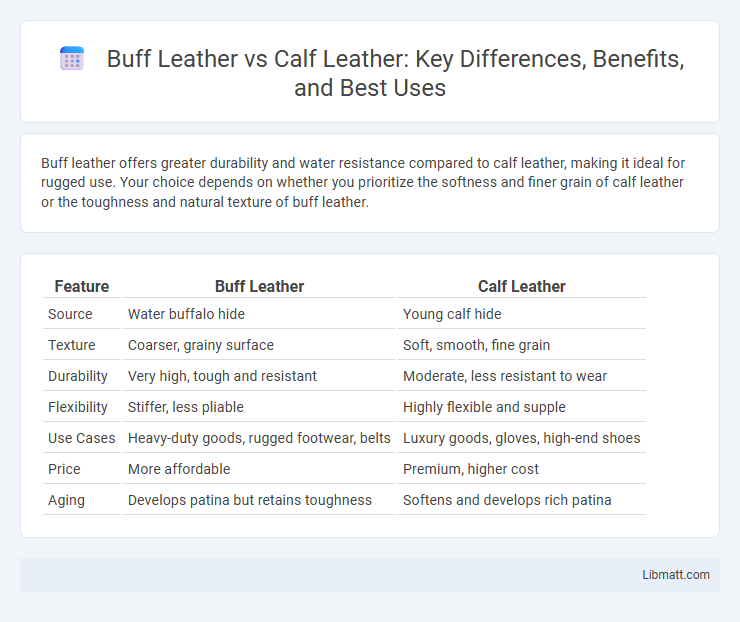Buff leather offers greater durability and water resistance compared to calf leather, making it ideal for rugged use. Your choice depends on whether you prioritize the softness and finer grain of calf leather or the toughness and natural texture of buff leather.
Table of Comparison
| Feature | Buff Leather | Calf Leather |
|---|---|---|
| Source | Water buffalo hide | Young calf hide |
| Texture | Coarser, grainy surface | Soft, smooth, fine grain |
| Durability | Very high, tough and resistant | Moderate, less resistant to wear |
| Flexibility | Stiffer, less pliable | Highly flexible and supple |
| Use Cases | Heavy-duty goods, rugged footwear, belts | Luxury goods, gloves, high-end shoes |
| Price | More affordable | Premium, higher cost |
| Aging | Develops patina but retains toughness | Softens and develops rich patina |
Introduction to Buff Leather and Calf Leather
Buff leather, derived from water buffalo hides, is renowned for its toughness, durability, and natural grain texture, making it ideal for heavy-duty leather goods. Calf leather, sourced from young cattle, offers a smooth, soft finish with fine grain, prized for luxury products like high-end shoes and handbags. Your choice between buff leather and calf leather depends on the desired balance of strength and elegance for the final product.
Origin and Source of Buff Leather
Buff leather originates from the hide of water buffalo, primarily sourced from Southeast Asia, India, and parts of Africa, known for its durability and coarse texture. Calf leather is derived from the skin of young calves, usually from European countries, prized for its softness and fine grain. Your choice between buff leather and calf leather depends on desired texture and strength, with buff leather offering rugged resilience from its unique origin.
Origin and Source of Calf Leather
Calf leather originates from young calves, primarily sourced from dairy or veal industries, known for its fine grain and smooth texture. This leather's origin contributes to its reputation for softness, durability, and high-quality finish compared to buff leather, which comes from mature buffalo hides. The controlled rearing and younger age of calves result in calf leather being more supple and ideal for luxury leather goods.
Key Differences in Appearance
Buff leather features a coarser, more pronounced grain with natural wrinkles and a rugged texture, making it popular for durable goods and casual styles. Calf leather boasts a finer, smoother surface with a consistent grain pattern, resulting in a polished and elegant appearance often favored for luxury accessories and formal footwear. The visual contrast between buff's rustic, textured look and calf's sleek, refined finish defines their distinct aesthetic appeal.
Durability Comparison: Buff vs Calf Leather
Buff leather offers superior durability due to its thicker grain structure and natural resistance to abrasion, making it ideal for heavy-use items. Calf leather, while softer and more supple, is less resistant to wear and may show scratches more easily over time. Your choice depends on whether long-lasting toughness or refined appearance is the priority.
Texture and Softness Analysis
Buff leather features a coarser, more pronounced grain texture and is generally thicker, providing robust durability while maintaining a slightly firm feel. Calf leather is prized for its fine, smooth surface and exceptional softness, making it ideal for luxurious, supple products that mold comfortably to your touch. Choosing between the two depends on whether your preference leans toward buff leather's rugged texture or calf leather's silky softness.
Common Uses in Fashion and Accessories
Buff leather, known for its sturdy and coarse texture, is frequently used in durable accessories like belts, wallets, and rugged footwear designed for heavy use and outdoor activities. Calf leather, prized for its soft, smooth texture and fine grain, is predominantly chosen for high-end fashion items such as luxury handbags, dress shoes, and tailored gloves that require a refined appearance and supple feel. Both leathers serve distinct roles in fashion, with buff leather emphasizing durability and calf leather highlighting elegance.
Price and Value Considerations
Buff leather generally offers greater durability at a lower price point compared to calf leather, making it a cost-effective choice for long-lasting products. Calf leather, prized for its softness and fine grain, carries a higher price due to its premium quality and luxurious feel. Consumers seeking a balance between affordability and durability often lean towards buff leather, while those prioritizing elegance and smooth texture usually prefer calf leather despite its higher cost.
Maintenance and Care Tips
Buff leather requires regular conditioning to maintain its moisture and prevent cracking, while calf leather demands gentle cleaning with mild soap to preserve its smooth texture. Both materials benefit from avoiding prolonged exposure to direct sunlight and water, which can cause discoloration and damage. Using a soft cloth to remove dust and applying appropriate leather protectants enhances durability and keeps the leather looking pristine.
Which Leather Should You Choose?
Buff leather offers superior durability and water resistance, making it ideal for heavy-use items like work boots and outdoor gear. Calf leather provides a softer texture and luxurious finish, preferred for high-end fashion accessories and formal footwear. Choose buff leather for rugged strength and longevity, or opt for calf leather when seeking elegance and comfort.
Buff leather vs calf leather Infographic

 libmatt.com
libmatt.com